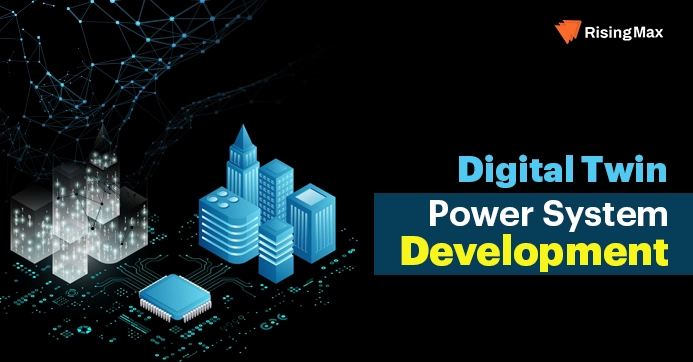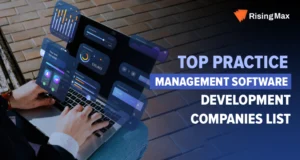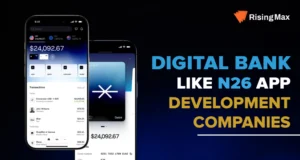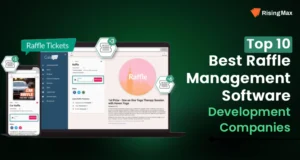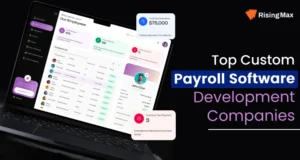Digital twin technology is creating a wide range of scope for each type of business and industry. Developing a digital twin platform for your platform will be a 360-degree solution. It can be anything like a digital twin city, digital twin university, digital twin power system, etc.
The digital twin platform will be the replica of the real-world thing. For example, if a government or energy-producing company is building an energy system digital twin platform, they can reduce many unfortunate situations.
In this blog, you will get to know the benefits of the digital twin power system and how you can create a space with fewer mistakes and easy procedures to resolve the issues with the digital twin platform.
The digital twin platform is a robust technology with great potential to grow in the market and make a better solution for governments and power-generating companies. RisingMax inc. is the leading digital twin development company with advanced building technologies and experienced developers. Get in touch with us for the digital twin power system.
Given that they are constructed using information and communication technology and somehow interact with the real world, digital twins are a well-known example of cyber-physical systems.
Sometimes they are a cyber-physical system as well as representing it: The communication links of the network-based controls must likely also be modeled in the twin if the real-world system, for example, includes both a physical process and a digital distributed control system.

Let’s take a tour of the energy system digital twin possibilities:
Energy System Digital Twin Use Cases
Here are some of the use cases of the energy system digital twin that can be implemented for the platform.
Optimization Of The Energy Production
improved power plant efficiency through better planning, monitoring, and management of the energy system’s assets. Energy producers will be able to estimate and optimize energy production more accurately and decrease the risk of energy being curtailed or not monetized by using a representation of the current state of a system in conjunction with external sources like forecast models (e.g., weather, demand, pricing).
Real-Time Forecasting
To guide decisions on network reinforcement, real-time and anticipatory supply and demand must be balanced within the overall system’s constraints.
This can aid in analyzing the network and identifying potential capacity issues, increased intermittent generation, etc. This is built on the integration of demand, retail, distributor networks, and energy systems and producers.
Flexibility
Increase the rate at which renewable generation is added to the network and increase the predictability of the systems by monitoring generation facilities, storage, and demand.
Power system flexibility becomes essential for preserving cost-effectiveness and reliability, which impacts how infrastructure is long-term planned and operated.
Linking Connections
Recognizing the interdependencies and expanding synergies between the production and transmission of gas and electricity, such as heat pumps or hydrogen conversion.
The coordination and efficient functioning of the gas and electricity networks will be aided by an integrated virtual representation of both systems, from generation to transmission and distribution.
Transmission & Distribution Of Power
Market regulations and service definitions, transmission, and distribution networks have an expanding number of commercial agreements with different market participants that provide power and balancing services.
Service providers have the option to contract with both distribution and transmission networks. The likelihood of conflicts arising from divergent directions being issued to service providers can be decreased by making those commercial levels and agreements apparent and by keeping track of when services are required.
Benefits Of Digital Twin
- Enhancing network planning analysis and remote asset monitoring to conserve resources and reduce the need for time-consuming physical inspections.
- Supplying a more comprehensive grid model to make infrastructure planning for various demands easier (such as installing electric vehicle chargers and connecting solar photovoltaic systems and energy storage systems).
- Reducing carbon emissions and improving the security and stability of the energy supply.
- Enhanced asset condition monitoring and prioritization of asset replacement through the use of a decision-making tool that can identify hazards and rank grid asset replacement plans.
- Better network utilization when balancing new or peak electrical loads can improve network planning analyses.
- Identification of potential synergies between asset replacement and upgrades for load increase without compromising grid resilience will help you get the most out of your investment in assets.

Digital Twin Technological Scenario
Superior System Planning
The development of a risk-based decision-making technique on a single platform that takes into account network criticality and asset health status to optimize asset planning in a financially and operationally efficient way.
Component Design
To describe the real deterioration characteristics (including at a material level) and determine the lifespan, the component design delivers a material degradation software model of key components and a digital twin of the switchgear’s essential components.
Failure Investigation
Creating software solutions that analyze the fundamental causes of failures, anticipate future failure probability or lifespan, take into account local operating conditions, failure statistics, and maintenance data, and implement ease the steps to reduce future distribution equipment failure rates.
Improvements In Monitoring
To improve the utility asset management strategy, an innovative, cost-efficient, and online Condition Monitoring (CM) solution is being created to monitor distribution switchgear in real time and incorporates trending analysis. The future solution will make use of sensing technology to provide affordable partial discharge (PD) sensors as well as integrated circuits (IC), artificial intelligence (AI), and machine learning (ML) for identification to facilitate switchgear.
Hire RisingMax inc. for the digital twin power system development with advanced features and unmatched USPs. We are the leading digital twin development company who are serving the industry for the last 13 years and hold the experience of 6+ years in developing decentralized platforms.
Power System Digital Twins
One of the most intricate digital twin systems that humans have ever created is the power system, and the digital twin technology is one of the most promising ones that facilitate its transfer to a new age of industry and the internet of things. But there are many obstacles to overcome on the way to this change.
A comprehensive strategy is needed to solve issues, including modeling, data management, storage, computing requirements, and scalability in order to fully harness the promise of the digital twin technology in the power system.
Even while the majority of these problems may be solved with the help of high-performance computing facilities and cutting-edge technologies like cloud computing, the problems with modeling and data management need more than just engineering expertise.
Additionally, it will be difficult to effectively strike a balance between the accuracy of digital twin forecasts and the optimization of computing complexity needed for diverse types of models/data. In this context, extensive research has just lately been conducted.
The power system’s control center technology is expected to advance to the digital twin idea in the future. The power system control room will benefit from the addition of sophisticated decision support, dynamic observability, and evaluation capabilities thanks to the adoption of the digital twin concept.
As a result, several operations that were a part of the offline regime of the power system operation, such as system stability analysis, system planning, model validation, and disturbance analysis, can now be included in the online regime.
In addition, more complicated frameworks will take the place of the low-dimensionality models used by the situational awareness systems in conventional control rooms.
The model-based approach, the data-driven approach, or a combination of both can be used to categorize the digital twin frameworks for power systems that have been suggested in recent research.
Integrated Energy Systems Digital Twins
An energy system that is more interconnected and integrated is made possible by the growing deployment of P2X energy converters in residential, commercial, and industrial settings.
A digital twin can significantly improve the performance and dependability of such an integrated system. Consider a local energy system owner who operates a district heating and electricity distribution network.
The energy system operator is observing changes in the topology of its network due to factors like an increase in rooftop solar, the adoption of smart appliances, the switch to electric heating, etc., which make its control area a significantly more complicated entity. The energy system operator can monitor and forecast system health using the digital twin in conjunction with advanced physical models of the network to verify the network’s dependability.
As a virtual reproduction of the existing system, the digital twin permits testing and experimentation. For example, it allows for the analysis of the effects of adopting newer technology and the capacity additions required to support electrification.
The planned or predictive maintenance of its assets is another application of the digital twin for the energy system operator. The energy system operator may anticipate network and asset health and take preventive action by using the most up-to-date representation of the network, which is made possible by the continuous stream of data, along with past measurements and comprehensive models.
For instance, real-time measurements and physical models of the network can be used to assess how the system would behave in the near future (hours to days in the future) in the case of occurrences like line faults in the electric network or water leaks in the district heat network, etc.
Digital twin technology can assist in the design and management of individual entities, such as industrial processes and homes, in addition to system operators.
Digital twin technology can assist owners of P2X assets in integrated energy systems in both maximizing the performance of these devices and using real-time data to check their health. Reducing the downtime of the network and the devices inside it increases operational efficiency and lengthens the operational lifetime. Modeling and simulation are crucial in each of the aforementioned cases.

Conclusion
The digital twin platforms are robust technology with great scope for running the business and omitting unfortunate situations. It will help instantly resolve the power plant issue and connection with perfection. Hire RisingMax Inc. for the energy system digital twin platform development and be the top company in your business sector.

